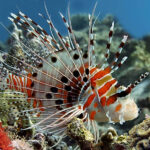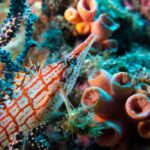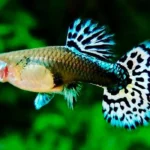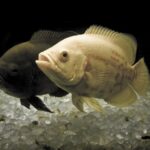Meet the Triggerfish: Defining Features and Families
Triggerfish Flattened, oval bodies with strong jaws and teeth made for crushing shells.
Eyes are located high on the head and can move independently for a better field of view.
Bold hues: their bodies are dominated by yellows, blues, and greens and intricate patterns. oval, flattened bodies with powerful jaws and teeth designed to crush shells.

Habitat: Coral Reef Strongholds
Native to tropical and subtropical oceans — Indo-Pacific, Caribbean, and Red Sea hotspots.
Prefer coral reefs, lagoon environments, and rocky coastal areas with hiding crevices.
Their homes are often small caves or tight spaces in coral, used as shelters and nesting areas.
Depth range varies from shallow reef flats to deeper reef slopes (~5 to 50 meters).
Because they are territorial, they often claim a specific patch of reef as their own.
Anatomy of Defence: The “Trigger” Mechanism
Named for a unique fin-locking system: the first dorsal spine can be locked into an upright position.
The second spine acts like a “trigger,” releasing the first when danger passes.
This helps wedge them into rock crevices, making extraction by predators nearly impossible.
Adds to their fierce reputation — they don’t flee; they hold their ground.
Many species will also turn sideways and flash their colors to warn intruders.
Known to charge intruders (including humans) who get too close to nests.
Use spiral attack paths from below when defending territory — a smart defensive manoeuvre.
Despite their aggressive image, they are essential for reef balance.
Feeding Habits: The Crunch Masters
Trigger have incredibly powerful jaws capable of crushing:
Sea urchins
Crustaceans
Mollusks
Hard coral polyps (some species)
Also feed on algae, tunicates, sponges, and small fish.
Often observed flipping rocks or puffing sand to uncover hidden prey.
Their diet helps control invertebrate populations, like coral-eating sea urchins.
Breeding and Nesting: Fierce Parental Instincts
Breeding season typically coincides with warm summer months.
Males establish and fiercely guard a territory or “harem area,” attracting multiple females.
Females lay eggs in shallow sand depressions dug by the males.
After fertilization, females vigilantly guard the nest, fanning it with fins to aerate the eggs.
Both males and females can become violently aggressive if the nest is threatened.
Hatching occurs in 24–48 hours, and larvae are planktonic until mature.
Triggerfish and Divers: A Love-Hate Relationship
Divers often report close encounters with fish.
Some divers enjoy the interaction; others are wary of surprise “charges.”
Titan trigger, in particular, has a reputation for attacking intruders.
Best practice: swim horizontally away, not vertically, to avoid getting inside the cone of aggression.
Despite their boldness, they are not naturally aggressive unless provoked or guarding eggs.

In the Aquarium: Challenges and Rewards
Some species, like the Picasso and clown triggerfish, are popular in saltwater aquariums.
Not for beginners — they require
Large tanks (100+ gallons)
Strong filtration
Secure lids (they may jump)
A meaty diet and a variety of enrichment
Can be aggressive toward tank mates — best kept with similarly sized, robust fish.
Known to rearrange decor or bite equipment out of curiosity.
Despite challenges, their intelligence and vibrant personalities are rewarding.
Ecosystem Role: Unsung Reef Protectors
Triggerfish help maintain reef health by controlling
Sea urchin populations (especially important where urchin overgrowth damages coral)
Crustacean overpopulation
Their digging and foraging disturb the substrate, which aids aeration and microfauna distribution.
Nest-building behavior can temporarily damage coral but leads to localized biodiversity.
Some reef conservation projects study triggerfish as indicators of reef recovery or imbalance.
Species Spotlight: Meet the Boldest
Titan Triggerfish (Balistoides viridescens)
Largest of all triggerfish, reaching up to 30 inches.
Infamous for their nesting aggression during breeding season.
Found in Indo-Pacific coral reefs.
Queen Triggerfish (Balistes vetula)
One of the most beautifully colored species — blues, purples, yellows.
Native to the Caribbean and western Atlantic.
Less aggressive than the Titan, but still highly territorial.
Picasso Triggerfish (Rhinecanthus aculeatus)
Named for its abstract, artistic pattern.
Very popular in aquariums.
Small to medium in size, but very active and bold.
Clown Triggerfish (Balistoides conspicillum)
Distinct black body with white spots and a yellow mouth.
A true showstopper — often seen in public aquariums.
Requires large tanks and isolated conditions in captivity.
Defense Beyond the Trigger: Teeth, Armor, and Intelligence
Triggerfish teeth are always visible, strong, sharp, and constantly growing.
Outer skin is tough and sandpaper-like, helping prevent predator bites.
Will often bite if handled or provoked, especially in nesting season.
Their sharp memory and pattern recognition make them quick learners in captivity.
Threats in the Wild: Natural and Human
Natural predators: large sharks, groupers, and moray eels.
Eggs and juveniles are highly vulnerable to small reef predators.
Human threats include:
Overfishing (especially in artisanal fisheries)
Aquarium trade
Reef destruction and coral bleaching
Some species are hunted as delicacies in Southeast Asia.

Conservation: Protecting the Reef’s Warriors
Most triggerfish species are not currently endangered, but local declines are noted.
Conservation efforts focus on
Marine protected areas (MPAs)
Sustainable reef tourism
Education on their role in reef ecosystems
Responsible aquarium trade practices can help limit wild population stress.
Ongoing reef degradation could affect their habitat and prey base.
Triggerfish Myths and Misconceptions
Myth: All triggerfish are dangerous. Reality: Only a few are aggressive, and usually only seasonally.
Myth: They destroy reefs—reality: Their digging can help oxygenate sand and redistribute nutrients.
Myth: They are solitary and dull.
Reality: Many are social, intelligent, and recognize individuals in aquariums.
What Makes Them So Bold?
A combination of natural armour, weaponised jaws, and territorial instinct makes them uniquely brave.
Most fish flee from danger — triggerfish assess, posture, and even defend smaller fish within their territory.
Evolution has favored their stand-your-ground strategy in competitive reef zones.
Their boldness makes them both feared and admired in marine circles.
Fascinating Facts: Did You Know?
Some triggerfish species can change colors to blend in or display mood.
Their swim style is unique, relying on undulating dorsal and anal fins rather than tail propulsion.
Juvenile triggerfish often hide among seagrass or floating debris for safety.
Triggerfish have individual personalities — some in captivity are shy, others are interactive.
A Titan triggerfish once made headlines by chasing a group of divers for over 30 meters!
Human Connection: From Myth to Modernity
Historically featured in Polynesian, Japanese, and Hawaiian folklore.
In some cultures, they are considered protectors of the sea or signs of good fortune.
Today, it is featured in ocean documentaries, reef tours, and public aquariums.
Their behaviors offer insights into reef intelligence and ecological adaptation.

Conclusion
Triggerfish are more than just abrasive reef dwellers; they are also intelligent, vital, and singularly courageous. Their actions have an impact on the structure and dynamics of the reef, and their presence indicates a healthy and balanced reef.
Whether admired from a dive mask or an aquarium glass, they remain some of the most unforgettable fish in the ocean. As reef ecosystems face growing threats, understanding and respecting triggerfish is more important than ever.
You are not just seeing a fish with flashing colors and sharp teeth. You are witnessing a reef watchman. a brave protector in a fragile world.
FAQs
Why are they called triggerfish?
The name “triggerfish” comes from their unique dorsal spine mechanism. When threatened, they can lock the first dorsal spine upright using the second one, like a trigger lock, to wedge themselves into rocks, making it hard for predators to remove them.
Can triggerfish live in a home aquarium?
Yes, many species can be kept in saltwater aquariums, but they require large tanks, plenty of space, and robust tank mates due to their territorial and sometimes aggressive nature. Picasso, clown, and Niger triggerfish are all common species found in aquariums.
How many types of triggerfish are there?
Triggerfish are classified into multiple genera and consist of approximately 40 species. They are typically found in tropical and subtropical oceans, particularly in the Indo-Pacific region near coral reefs.
How do triggerfish protect their nests?
Female triggerfish dig nests in the sand and fiercely guard them. They become extremely territorial during the spawning season. In order to ward off intruders, including much larger animals and occasionally humans, they frequently swim in a vertical position and patrol a cone-shaped area above their nests.
What are the most colorful species of triggerfish?
The Picasso triggerfish (Rhinecanthus aculeatus) features striking hues and patterns. Black clown triggerfish (Balistoides conspicillum) with yellow lips and white spots, Queen Triggerfish (Balistes vetula)—vibrant blues and greens with streamers.










